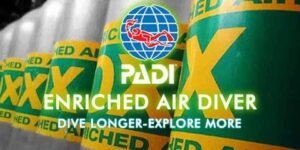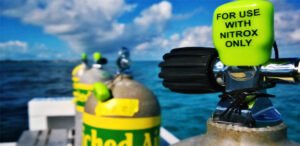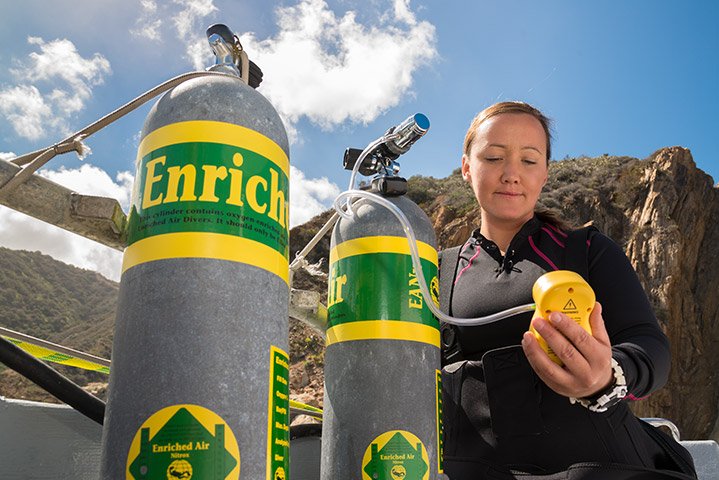Introduction to Nitrox vs Air
In the realm of recreational diving, understanding the differences between Nitrox and normal air is essential for making informed decisions about dive planning and safety. Normal air, which is the standard breathing gas for most divers, is composed of approximately 21% oxygen and 79% nitrogen. This balance of gases is what divers breathe when they use a standard scuba tank.
Nitrox, on the other hand, refers to any gas mixture with a higher concentration of oxygen than the 21% found in normal air. The most common Nitrox blends used in diving are EAN32 (32% oxygen) and EAN36 (36% oxygen). These mixtures are specifically tailored to reduce the amount of nitrogen a diver inhales, which in turn lowers the risk of decompression sickness (DCS), commonly referred to as “the bends.”
The primary purpose of using Nitrox in diving is to extend bottom times and reduce the risk of nitrogen-related issues. By breathing a gas with more oxygen and less nitrogen, divers can stay underwater longer at certain depths without increasing their risk of DCS. This benefit is particularly valuable for divers who are planning multiple dives over a short period, as it allows for shorter surface intervals and increased overall dive time.
Understanding these foundational differences between Nitrox and normal air is crucial for divers who are considering the use of Nitrox in their diving activities. It not only offers potential safety benefits but can also enhance the overall diving experience by providing longer and more enjoyable dives. The subsequent sections will delve deeper into the specific benefits and considerations of using Nitrox, focusing on the differences between the 32% and 36% mixes.
Why Divers Use Nitrox
Divers often opt for Nitrox, a gas blend with higher oxygen content than normal air, due to its range of advantages. One of the primary benefits of using Nitrox is the extended bottom time it affords. Traditional air contains approximately 21% oxygen, while Nitrox blends typically contain 32% or 36% oxygen. This increased oxygen percentage allows divers to stay underwater longer at certain depths without exceeding no-decompression limits. This benefit is particularly valuable for recreational divers who wish to maximize their underwater exploration during each dive.
Another significant advantage of using Nitrox is the reduced nitrogen absorption. When diving with normal air, the body absorbs nitrogen, which can lead to decompression sickness if not properly managed. By using Nitrox, divers inhale less nitrogen, thereby decreasing the risk of nitrogen-related issues. This reduction in nitrogen absorption also results in potentially shorter surface intervals. Divers using Nitrox can often undertake multiple dives in a day with less waiting time between them, enhancing their overall diving experience.
Moreover, Nitrox is especially beneficial for certain groups of divers. Recreational divers who engage in repetitive dives, such as those on liveaboard trips, can significantly benefit from the reduced nitrogen load. This is because repetitive diving increases nitrogen absorption, and using Nitrox mitigates this effect. Additionally, divers who are older or have a higher susceptibility to decompression sickness may find Nitrox to be a safer option, allowing them to enjoy their dives with greater peace of mind.
In summary, the use of Nitrox over normal air offers several compelling benefits, including extended bottom time, reduced nitrogen absorption, and potentially shorter surface intervals. These advantages make Nitrox an attractive choice for recreational divers and those engaging in repetitive dives, ensuring a safer and more enjoyable diving experience.
Understanding Oxygen Percentage: 32% vs 36% Mix
The primary distinction between 32% and 36% Nitrox mixes lies in the oxygen content, which significantly impacts various aspects of dive planning and safety. The 32% Nitrox mix contains 32% oxygen and 68% nitrogen, whereas the 36% mix comprises 36% oxygen and 64% nitrogen. This difference, albeit minor, brings about notable changes in diving dynamics.
First and foremost, the increased oxygen content in the 36% mix allows for longer bottom times compared to the 32% mix. This is because the higher oxygen percentage reduces the amount of nitrogen absorbed by the body during the dive, which in turn extends the no-decompression limits. For instance, at a depth of 18 meters (60 feet), a diver using a 32% mix can stay underwater for approximately 60 minutes without requiring decompression stops. On the other hand, the same diver using a 36% mix can extend their bottom time to around 70 minutes.
However, while extended bottom times are advantageous, they come with increased safety considerations. A higher oxygen content elevates the risk of oxygen toxicity, particularly at greater depths. The 32% mix generally allows for deeper dives compared to the 36% mix, which is more restrictive due to the elevated partial pressure of oxygen. This necessitates meticulous dive planning, including adhering to maximum operating depths (MOD) to avoid oxygen toxicity. For the 32% mix, the MOD is approximately 34 meters (112 feet), whereas for the 36% mix, the MOD is reduced to around 28 meters (92 feet).
Another aspect to consider is the overall dive experience. Divers using a 36% mix often report feeling less fatigued post-dive, as the higher oxygen levels facilitate better off-gassing of nitrogen during ascent. This can enhance the comfort and safety of repetitive dives. Conversely, the 32% mix, while slightly less forgiving in terms of bottom time, offers greater depth flexibility, making it a preferred choice for divers who plan to explore deeper underwater environments.
In summary, the choice between 32% and 36% Nitrox mixes should be guided by specific dive objectives, depth requirements, and safety considerations. Both mixes offer distinct advantages and potential risks, necessitating thorough understanding and careful planning to maximize their benefits while ensuring a safe diving experience.
Safety Considerations When Using Nitrox
Diving with Nitrox, whether it’s a 32% or 36% mix, offers numerous benefits, but it also necessitates stringent safety precautions. The increased oxygen content in Nitrox compared to normal air requires divers to undergo specialized training. Proper training is essential to understand the unique risks associated with Nitrox, including the danger of oxygen toxicity, which can occur if a diver exceeds the maximum operating depth (MOD) for the given oxygen percentage.
Nitrox-compatible equipment is another critical safety consideration. Standard diving gear may not be suitable due to the higher oxygen levels. For instance, regulators and tanks must be cleaned and maintained to avoid any potential reactions with oxygen, which could lead to fires or explosions. Divers must ensure their equipment is labeled and certified for Nitrox use, adhering to the guidelines provided by training agencies.
Monitoring oxygen exposure is paramount when diving with Nitrox. Divers should use dive computers capable of tracking oxygen levels and calculate their oxygen exposure over the course of multiple dives. This helps prevent cumulative oxygen toxicity, which can be harmful, especially on extended dive trips. It’s crucial to stay within the recommended oxygen exposure limits to ensure safety.
Handling potential risks associated with higher oxygen mixes involves meticulous dive planning. Divers must be vigilant about their depth limits, as exceeding the MOD can significantly increase the risk of oxygen toxicity. Additionally, they should be aware of signs and symptoms of oxygen toxicity, such as visual disturbances, nausea, and muscle twitching, and be prepared to ascend immediately if these symptoms occur.
In summary, diving with Nitrox requires a thorough understanding of its specific safety considerations. Proper training, appropriate equipment, and diligent monitoring of oxygen exposure are essential steps to mitigate risks and fully enjoy the advantages of Nitrox diving. By adhering to these safety measures, divers can enhance their underwater experience while maintaining their well-being.
Physiological Benefits of Nitrox
The use of Nitrox, particularly mixes of 32% and 36% oxygen, offers several physiological benefits for divers compared to normal air. One of the primary advantages is the reduced risk of decompression sickness (DCS). Decompression sickness occurs when nitrogen absorbed by body tissues under pressure forms bubbles as the pressure decreases during ascent. By using Nitrox, which has a lower nitrogen content than normal air, divers reduce the amount of nitrogen absorbed into their tissues, thereby decreasing the likelihood of nitrogen bubble formation and the associated risks of DCS.
Another significant benefit of diving with Nitrox is the reduced nitrogen loading. This not only minimizes the risk of decompression sickness but also allows divers to spend more time at depth compared to using normal air, providing extended bottom times and enhancing the overall diving experience. The lower nitrogen absorption also means that divers can perform multiple dives in a day with shorter surface intervals, as the reduced nitrogen load facilitates quicker off-gassing during these intervals.
Furthermore, many divers report feeling less fatigued after dives when using Nitrox. This reduction in post-dive fatigue is attributed to the lower nitrogen absorption, which alleviates the body’s need to process and eliminate large amounts of nitrogen. The decreased workload on the body can result in a more refreshed feeling after diving, potentially allowing divers to enjoy more activities post-dive without experiencing the usual exhaustion.
Overall, the physiological benefits of using Nitrox extend beyond just reducing the risk of decompression sickness. The extended bottom times, shorter surface intervals, and reduced post-dive fatigue collectively contribute to a more enjoyable and safer diving experience. Understanding these benefits highlights why many divers opt for Nitrox over normal air, particularly in scenarios requiring multiple dives or longer durations underwater.
Planning Dives with Nitrox
Planning dives with Nitrox involves several critical considerations to ensure both safety and the maximization of benefits associated with using enriched air. One of the primary aspects is calculating the Maximum Operating Depth (MOD) for the specific Nitrox mix being used. MOD is essentially the depth at which the partial pressure of oxygen reaches a limit, typically 1.4 ATA (atmospheres absolute) for recreational diving. For instance, a 32% Nitrox mix has a shallower MOD compared to a 36% mix, due to its lower oxygen content. Accurately determining the MOD is vital to preventing oxygen toxicity, a serious risk that can occur if divers exceed safe oxygen exposure limits.
Utilizing Nitrox dive tables or dive computers designed for enriched air is another essential component in planning dives. These tools help divers to track their nitrogen absorption rates more precisely, allowing for extended bottom times and shorter surface intervals compared to diving with normal air. Dive computers with Nitrox capabilities offer real-time data adjustments, making it easier to manage dive profiles and adhere to safety limits. It is important for divers to be thoroughly familiar with their specific dive computer’s settings and functions related to Nitrox.
Pre-dive checks are indispensable in ensuring the correct gas mix. This includes verifying the oxygen content within the tank using an oxygen analyzer and confirming that the mix matches the planned dive parameters. Proper labeling of tanks, accurate record-keeping, and clear communication with dive partners are also crucial steps in this process. These checks help prevent mix-ups and ensure that divers are breathing the intended gas mixture underwater.
Adjusting dive plans based on the Nitrox mix being used is another critical factor. Divers must account for the different nitrogen absorption rates and oxygen toxicity limits associated with varying Nitrox blends. This often means recalculating bottom times, ascent rates, and surface intervals to align with the specific properties of the chosen Nitrox mix. By doing so, divers can safely optimize their underwater experience, enjoying longer dives and reduced decompression stress.
Cost and Availability of Nitrox
When considering the use of Nitrox for diving, the cost and availability are crucial factors. Nitrox fills are generally more expensive than normal air fills due to the additional processing and materials required. The cost can vary significantly depending on the location and the specific blend you choose—whether it is a 32% or 36% mix. On average, divers can expect to pay anywhere from 1.5 to 2 times the price of a standard air fill. While this might seem like a steep increase, the benefits of extended bottom times and reduced nitrogen absorption can make it a worthwhile investment for many divers.
Availability of Nitrox is another practical consideration. Most well-equipped dive shops and resorts offer Nitrox fills, especially in popular diving destinations. However, the availability might be limited in more remote or less frequented dive sites. It is advisable for divers to check with dive operators in advance to ensure that Nitrox will be available during their trip. The readiness of Nitrox at a dive location can often be a deciding factor for divers planning their excursions.
Obtaining Nitrox certification is a prerequisite for using enriched air mixes safely. The certification course, which typically includes theoretical lessons and practical training, covers essential topics such as the benefits and risks associated with Nitrox, proper handling, and how to use an oxygen analyzer. The course costs vary, but it is generally a one-time investment that can significantly enhance a diver’s experience and safety. For casual divers who dive infrequently, the additional cost of certification and Nitrox fills might not seem justified. However, for frequent divers, particularly those who engage in multiple dives per day, the advantages of using Nitrox can outweigh the initial investment.
In summary, while the cost of Nitrox fills is higher and availability might vary, the benefits of extended dive times and increased safety make it a compelling option for many divers. The requirement for Nitrox certification is an additional consideration, but for those who dive regularly, it is often seen as a valuable and worthwhile investment.
Conclusion: Making the Choice Between Nitrox and Normal Air
Deciding between Nitrox and normal air for your dives largely depends on your individual needs and preferences as a diver. Throughout this blog post, we have explored the key differences and benefits of using Nitrox, specifically the 32% and 36% oxygen mixes, compared to regular air. Understanding these differences is crucial for making an informed choice that enhances your diving experience.
Nitrox, with its increased oxygen content, offers several advantages over normal air. The primary benefit is the extended bottom time it allows, which can be particularly beneficial for repetitive diving. By reducing the amount of nitrogen absorbed by the body, Nitrox decreases the risk of decompression sickness, commonly known as “the bends.” This is a significant consideration for divers who frequently engage in multiple dives over a short period.
The 32% and 36% Nitrox mixes each have their specific use cases. The 32% mix is often preferred for deeper dives, providing a balanced extension of bottom time while maintaining a manageable depth limit. On the other hand, the 36% mix is ideal for shallower dives, further extending bottom time and reducing surface intervals. However, divers must be mindful of the maximum operating depth (MOD) for each mix, as exceeding these limits can lead to oxygen toxicity.
When choosing between Nitrox and normal air, consider your diving profile, the frequency of your dives, and your personal comfort with managing Nitrox’s specific requirements. For recreational divers who dive occasionally or do not exceed moderate depths, normal air may suffice. However, for those engaging in frequent, repetitive, or deeper dives, Nitrox can provide significant benefits in terms of safety and dive time.
Ultimately, the choice between Nitrox and normal air should be guided by your diving goals and the conditions you typically encounter. By understanding the benefits and limitations of each option, you can tailor your diving approach to maximize safety and enjoyment.
